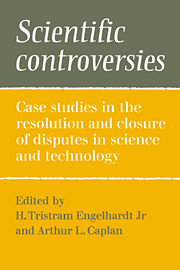 Scientific Controversies
Scientific Controversies Book contents
- Frontmatter
- Contents
- Preface
- List of contributors
- Introduction: Patterns of controversy and closure: the interplay of knowledge, values, and political forces
- PART I THEORETICAL PERSPECTIVES
- PART II CONTEMPORARY CASE STUDIES
- 12 Resolution of the Laetrile controversy: past attempts and future prospects
- 13 Federal regulation of Laetrile
- 14 Quasi libertarianism and the Laetrile controversy
- 15 Judicial deflection of scientific questions: pushing the Laetrile controversy toward medical closure
- 16 Politics, science, and the problem of psychiatric nomenclature: a case study of the American Psychiatric Association referendum on homosexuality
- 17 The diagnostic status of homosexuality in DSM-III: a reformulation of the issues
- 18 On arriving at the American Psychiatric Association decision on homosexuality
- 19 Values in the debate over workplace safety and health: the rancorous rhetoric about regulation
- 20 The successful experiment that failed
- 21 The power of efficiency: balancing benefits and costs in regulating occupational exposure to toxic substances
- 22 Closure in occupational safety and health: the benzene and cotton dust decisions
- 23 Nuclear fear: a history and an experiment
- 24 Closure and controversy: Three Mile Island
- 25 Understanding the nuclear power controversy
- PART III CONTROVERSY, CLOSURE, AND THE PUBLIC
- Author index
- Subject index
15 - Judicial deflection of scientific questions: pushing the Laetrile controversy toward medical closure
Published online by Cambridge University Press: 03 February 2010
- Frontmatter
- Contents
- Preface
- List of contributors
- Introduction: Patterns of controversy and closure: the interplay of knowledge, values, and political forces
- PART I THEORETICAL PERSPECTIVES
- PART II CONTEMPORARY CASE STUDIES
- 12 Resolution of the Laetrile controversy: past attempts and future prospects
- 13 Federal regulation of Laetrile
- 14 Quasi libertarianism and the Laetrile controversy
- 15 Judicial deflection of scientific questions: pushing the Laetrile controversy toward medical closure
- 16 Politics, science, and the problem of psychiatric nomenclature: a case study of the American Psychiatric Association referendum on homosexuality
- 17 The diagnostic status of homosexuality in DSM-III: a reformulation of the issues
- 18 On arriving at the American Psychiatric Association decision on homosexuality
- 19 Values in the debate over workplace safety and health: the rancorous rhetoric about regulation
- 20 The successful experiment that failed
- 21 The power of efficiency: balancing benefits and costs in regulating occupational exposure to toxic substances
- 22 Closure in occupational safety and health: the benzene and cotton dust decisions
- 23 Nuclear fear: a history and an experiment
- 24 Closure and controversy: Three Mile Island
- 25 Understanding the nuclear power controversy
- PART III CONTROVERSY, CLOSURE, AND THE PUBLIC
- Author index
- Subject index
Summary
It is generally presumed that whatever merits or demerits the judicial process may otherwise possess, that process is superior to scientific debate as a process of obtaining closure in that it provides a precise, definite, and final conclusion to any controversy, within a defined time, and according to a generally understood and formally delineated procedure. It is for this reason that plaintiffs seek resolution of disputes through litigation rather than through academic debates, constitutional conventions, or the vagaries of some other less well-defined processes. The notion that a lawsuit will inevitably lead to the formal resolution of any scientific issues that litigants place before the court is, however, fanciful. It supposes a very narrow view of judicial conduct and the judicial decision-making process: It assumes that the court can, and will, weigh scientific arguments that are cast in an adversary model and then simply declare a winner.
As others have suggested, such a model would not provide an adequate way to resolve scientific disputes, even if the judiciary were willing to undertake such efforts. Fortunately, the courts have generally recognized their inability to impose solutions to scientific questions. Instead the American judiciary has generally perceived its role as one of maintaining the integrity of the technical decision-making process by requiring those institutions better able to resolve matters of science to do the careful and adequate scientific work necessary for their resolution.
In participating in the Laetrile debate, the courts have been accused of attempting to step beyond the natural limitations of their competence and to resolve a scientific dispute.
- Type
- Chapter
- Information
- Scientific ControversiesCase Studies in the Resolution and Closure of Disputes in Science and Technology, pp. 355 - 380Publisher: Cambridge University PressPrint publication year: 1987
- 1
- Cited by


